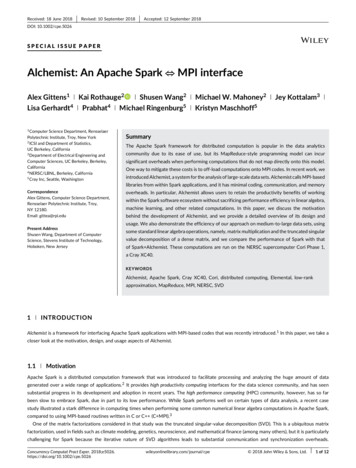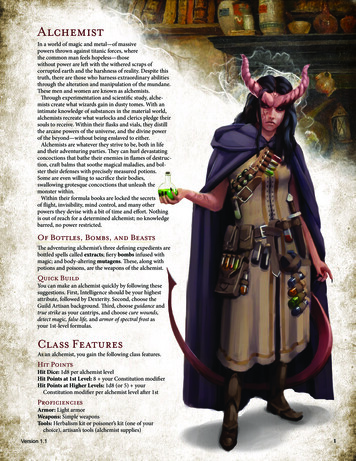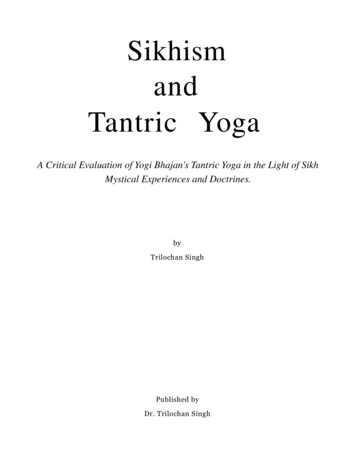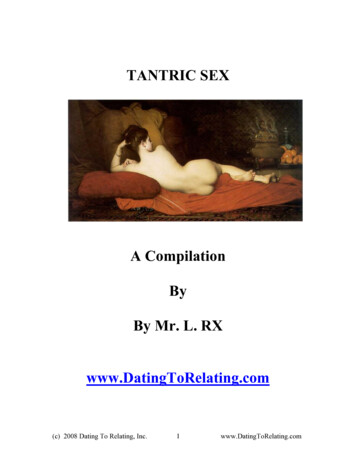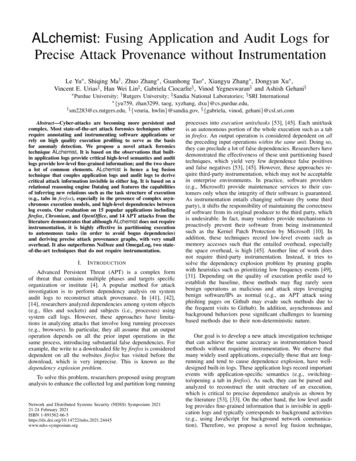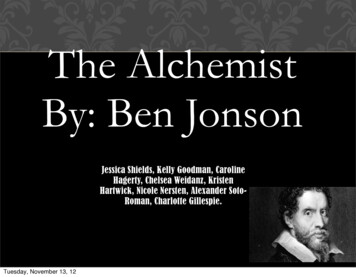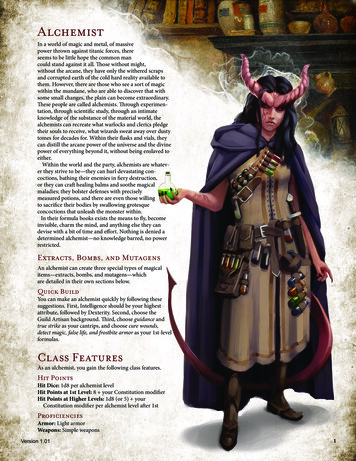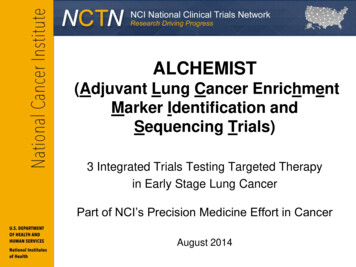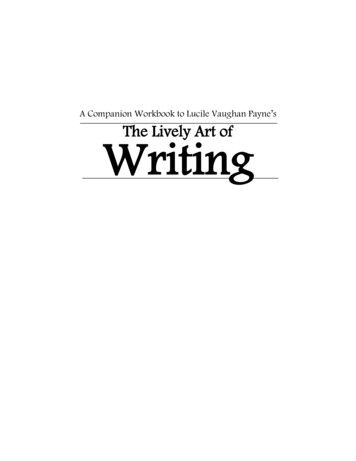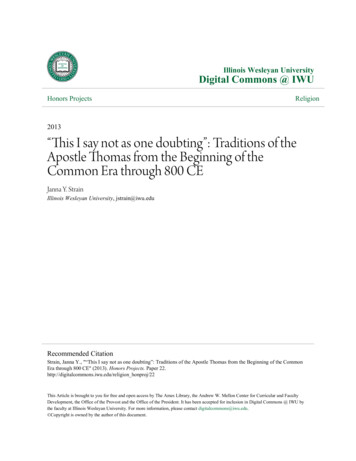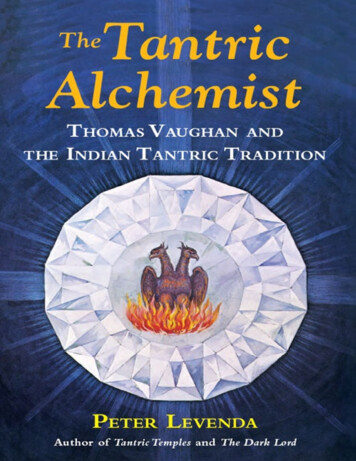
Transcription
In the seventeenth century the Welsh alchemist Thomas Vaughan, and his wife and alchemical partnerRebecca, died under mysterious circumstances. What they were doing and how it might have led totheir deaths has remained a secret . even though the true nature of their experiments is described incode in Vaughan's published works.Readers will find that the many disparate threads of an authentic spiritual tradition are woventogether here in a startling tapestry that reveals—without pretense or euphemism—the psycho-sexualtechnique that is at the root of both Tantra and Alchemy: that is to say, of both Asian and Europeanforms of esoteric praxis.Using the works of Vaughan as his text, Levenda applies the “twilight language” of Tantra to thesurreal prose of the alchemist and in the process lays bare the lineaments of the arcane tradition thatgave rise to the legend of Christian Rosenkreutz, the reputed founder of Rosicrucianism who learnedhis art in the East; and to the nineteenth and twentieth century occult movements lead by suchluminaries as P.B. Randolph, Theodore Reuss, Helena Blavatsky, and Aleister Crowley who alsosought (and discovered) this technology in the religions and cultures of Asia.
Published in 2015 by Ibis PressA division of Nicolas-Hays, Inc.P. O. Box 540206Lake Worth, FL 33454-0206www.ibispress.netDistributed to the trade byRed Wheel/Weiser, LLC65 Parker St. Ste. 7Newburyport, MA 01950www.redwheelweiser.comCopyright 2015 by Peter LevendaAll rights reserved. No part of this publication may bereproduced or transmitted in any form or by any means, electronicor mechanical, including photocopying, recording, or by any informationstorage and retrieval system, without permission in writing fromNicolas-Hays, Inc. Reviewers may quote brief passages.ISBN 978-0-89254-213-0Ebook: ISBN 978-0-89254-629-9Library of Congress Cataloging-in-Publication DataAvailable Upon requestBook design and production by Studio 31www.studio31.com[MV]Printed in the United States of America
DEDICATION
CONTENTSIntroductionSECTION ONE: NIGREDOONE:An Outline of the ProblemTWO:The Chemical Marriage of Thomas and Rebecca VaughanTHREE:The Alchemical LanguageSECTION TWO: ALBEDOFOUR:FIVE:SIX:The Hermetic ContributionThe Chinese ContributionThe Tantric ContributionSECTION THREE: RUBEDOSEVEN:The Anthroposophia TheomagicaEIGHT:The Anima Magica AbsconditaNINE:The Magia AdamicaCONCLUSION:Lumen de LumineGlossaryAcknowledgmentsA Note on SourcesBibliographyIndex
ILLUSTRATIONSThe Emerald Tablet by Heinrich KhunrathPhoto InsertSolutio PerfectaChinese AlchemistA Map of the Alchemical ProcessScholae Magicae TypusNei Jing Tu (Chart of the Inner Warp)Creation of the Inner EmbryoRelease of the Inner EmbryoIndian Chakras and the Human BodyAdam KadmonThe Alchemical EggMutus LiberConiunctio OppositorumPortae Lucis
INTRODUCTIONThere is no question, then, of developing new mythologies as if a mythology was a kind of fancy dress that made life more exciting. Thevery idea that mythology is something one invents suggests an unpardonable arrogance, as if myth were at our beck and call. Rather, itis we, the will of each and every one of us, that are at the beck and call of myth.— Roberto Calasso1. one may regard the myth as a projection of an existential reality which seeks its own truth in a total view of things .— Hans Jonas2I came to this study many years ago. In 1968, the University Press of New York published an editionof A. E. Waite's 1919 The Works of Thomas Vaughan: Mystic and Alchemist along with a newForeword by “Father of the Beats” Kenneth Rexroth (1905–1982). I had been studying another ofWaite's works, The Book of Ceremonial Magic, as well as Aleister Crowley's Magick In Theoryand Practice, along with a copy of the Dao De Jing in English translation. I was still in high schoolin the Bronx and, well, it was the Sixties.The very first article I wrote for my high school magazine (and thus the very first article I wroteabout anything) was about alchemy. It concerned the famous case of the seventeenth century scientistJan Baptist van Helmont (1579–1644) and a demonstration of the transmutation of base metal intogold in his presence, affirmed in his own writings. It was the Foreword by Rexroth in the Waitebook, though, that captivated me at the time and which still resonates all these decades later.3Rexroth set out the curriculum that I was to follow—from alchemy to Chinese and Indian alchemy,yoga, and Tantra—in order to understand what Thomas and Rebecca Vaughan were up to in theseventeenth century. In fact, it was Rexroth's allusion to Chinese alchemy that inspired me to begin astudy of written Chinese so that I would be able to locate and translate alchemical texts that had sofar not been made available in English. It was that study which developed into a serious interest inMandarin, that eventually—in 1984—found me fully involved in China trade and which set me on acourse that would see me spending the better part of three decades in Asia.All this because of a collection of writings by a seventeenth century Welsh alchemist and aforeword by a twentieth century American poet. Yet, I am not the only one to have been affected thisway by Vaughan's work.His reputation was revived in a work by Mary Anne Atwood (1817–1910) entitled A SuggestiveInquiry into Hermetic Philosophy. Originally published in 1850 and almost immediately pulledfrom circulation, most copies destroyed, this erudite and penetrating look at alchemy was the resultof Atwood's study of the subject while she still lived at home with her occultist father. It was herfather who suggested to her that she write what was essentially the prose version of a long, hermeticpoem he was composing. She did so, and her father had the 600-page book published, but withoutfirst reading it himself. When he finally did, he was shocked at the way his daughter had revealed somany alchemical secrets. He bought all the copies he could find and he and his daughter burned themin the garden outside their home, along with the only draft of his poem. A few copies of her bookescaped the holocaust, however, which is how we are able to read it today.She never wrote another book again even though she lived for sixty more years.There is much food here for speculation and wonder, and not a little sadness, but we will restrainourselves to the matter at hand, which is Atwood's appraisal of the work of Thomas Vaughan. Shewrites, “. the one Art and medium of vital perfectibility is more clearly shown in his writings thanin those of any other English author.”4 She also mentions his strange and controversial death, by
saying it was due to “an overdose of the elixir.”5It was this reference to Vaughan that excited A. E. Waite himself and moved him along a path ofesoteric study.6 This path eventually led him to the Hermetic Order of the Golden Dawn and to theauthorship of dozens of heavy tomes on virtually every occult science and discipline known at thetime: from works on Kabbalah to alchemy, ceremonial magic, secret societies, the Tarot, the HolyGrail, and the like.And it was due to Waite's fascination with Vaughan that this writer developed his own lifelonginterest, wound up in China, visited Daoist temples in Beijing and Shanghai, found himself running asales and marketing operation from a base in Kuala Lumpur, photographing Indian temples in Java,hunting Nazis in South America, and a host of other strange occupations . all because of ThomasVaughan, A. E. Waite, and Kenneth Rexroth.And especially because of alchemy.IN MY CAREER I HAVE PUBLISHED some dozen books or more, several of which have been translatedinto numerous languages, and I have written many more than I have actually published. Over thecourse of the past forty years or so people have asked me to diverge from my usual position ofuncommitted observer and reporter on such things as religion, politics, cults, and esoterica in orderto write or speak more frankly on what it is that I believe to be true. Normally, I leave that to readersto decide for themselves; I don't like it when someone who is supposed to be a historian orinvestigative journalist intrudes too much into the story being told. I like to make up my own mindabout things: just give me the data, the facts as they are known, and I will take it from there. At thesame time, I am very aware of the criticism levelled at historians and journalists that there is no wayto extricate oneself or one's point of view from the story being told. There is no absolute standard oftruth; every history is a narrative, a story being told from a specific point of view no matter how hardwe try to be objective. Indeed, my own research over the past decades has shown me that most ofwhat we believe to be history is actually carefully crafted fiction.In the case of such subjects as alchemy and Tantra this characteristic is even more pronounced.All works on both subjects (written by the practitioners themselves) are essentially works of fiction:they use a contrived language, replete with metaphor and allegory, disinformation and misdirection.The actual personalities and events described within these texts are surreal, impossible, and beyondordinary human experience. Yet the texts do reveal even as they conceal. Like many spiritual texts,they refer to otherworldly events and circumstances which the literal-minded would refer to asfantasies, delusions, etc. These texts fall within a twilight zone of literature: they purport to be aboutreal events and circumstances, but even a casual glance at them shows that this claim is difficult todefend, at least from a modern perspective in the aftermath of the scientific revolution. If they are notreal—or describe real events— then what are they about? They are obviously not meant to entertain:the language, while fantastical, often is difficult, turgid, even lugubrious. There is no perceivablestory line, no narrative voice. This, taken with the insistence that what is being discussed is not whatis being discussed, and you have an impossible text that defies any attempt at interpretation. Perhapsfor this very reason there is a cottage industry in alchemical texts as well as in books claiming to beTantric or to reveal Tantrism. After all, in the absence of any real information about either, one canpretty much say anything one wants by way of “revealing” the “truth” about alchemy or Tantra andwho is there to contradict?Astute readers will know that I have contributed to this literature myself, at least insofar as Tantrais concerned. But in my defense, I prefaced that work7 with a discussion of how difficult it is toauthoritatively describe Tantra, when Tantra itself resists all attempts at a clinical, unimpeachable,
description. For my evidence, I used the existing temples found all over the Indonesian archipelagoas a way of showing—through architecture and statuary—what Tantrism meant to the people wholived there in the past and to those who still use these temples today. It was while researching thatbook that I came to the gradual understanding that what I was seeing before my eyes was nothing lessthan an alchemical literature written in stone, the Asian equivalent perhaps of Fulcanelli's Gothiccathedrals. The obsessive focus on am ta—the Elixir Vitae of the alchemists—in the Javanesetemples was one key to this discovery; the focus on the lingam and yoni (the male and femalesymbols, respectively) in Javanese temple architecture was another. I had also spent considerabletime among the Chinese texts on Daoism, particularly a form of Daoism that has the most similaritywith Western alchemy, to see if there was any kind of a continuum of knowledge bridging Chinese,Indian and European forms of alchemy, and if one could use the terms of one discipline to decode theother.Of course, one can take these similarities too far and be accused of the sin of universalism; no oneis more sensitive to this critique than I. Thus, I decided to go back and review not only Tantricliterature—both primary and secondary sources—but also Western, European alchemical literature. Iwanted to see if I could “read” an alchemical text while using Tantric metaphor and allegory as mydecryption keys.The result is this book.I have left the work of demonstrating historical connections and influences to those academicswho have a head start on me in these areas, focusing instead on the actual process of alchemy andhow one could conceivably translate a work of alchemy into a Tantric text, and vice versa. I hope toshow that Western alchemy is nothing less than Indian Tantra and Chinese Daoism in European dress.There are other scholars who have approached this comparison gingerly and with an eye toprotecting their tenures. There are still others who—more secure in their professions—have comeforward with statements that are supportive of this point of view, such as Moshe Idel, Raphael Patai,and others. The influence of Asian forms of alchemy on European forms probably made its wayalong the Silk Route from Central Asia, and from there to Arab and Islamic scholars andpractitioners, before they surfaced in the European texts. It is also possible that this was two-waytraffic, and that discoveries made by European alchemists began to influence, in turn, their Asiancounterparts. Eventually someone will sort all this out but in the meantime life is short and thepurpose of this book is to jump-start the dialogue.THERE IS A CONTINUUM OF SORTS in my own life. My earlier focus on Javanese Tantrism led me to thediscovery that the iconic form of Tantra represented by Vajrayana or Tibetan Buddhism—theKālacakra Tantra—has its origins in Java. In other words, the Dalai Lama in his many initiationsworldwide in the Kalachakra tradition represents a Javanese Buddhist and Javanese Tantric lineage;of which the Dalai Lama's consecration of Borobudur in Java is but one acknowledgment. My ownwork on the Kalachakra Tantra (begun in 2007) proceeds apace, but in the meantime what I offerhere is an approach to both Tantra and alchemy that attempts to clarify some of the central issues ofboth. My thesis has ramifications for the study of Kabbalah and Jewish mysticism, as well, as itbecomes increasingly difficult to study any of these disciplines in a vacuum. Kabbalah—particularlythe Zohar—has many elements in common with Tantra and some Kabbalistic ideas are representedin the works of European alchemists. What we have here is nothing less than the rudiments of the“secret tradition” that has been hinted at or claimed by various societies and guilds over thecenturies. It requires only a different perspective in order to see the outlines of this tradition comeinto sharper focus.I hasten to add—as I have before, in other places—that I am not the recipient of any esoteric
lineage or occult initiation, so I am not breaking any vows. What I discover, I do so on my own.Therefore any mistakes I make are also my own. True, I have spent considerable time studyingvarious spiritual and religious disciplines up close and personal (rather than solely from the comfortof a library or computer screen), and these include the Black Crown initiation from the 16th GyalwaKarmapa when he visited New York City in 19768; learning how to pray in various mosques aroundthe world; making offerings and meditating in Chinese Buddhist temples in New York, Singapore,Beijing, Shanghai, Hong Kong, Melaka, and elsewhere; attending Afro-Caribbean rituals in variousplaces around the world; and, of course, my youthful episode among the Eastern Orthodox churchesand their “wandering” versions, through which I obtained ordination, elevation, and consecrationover a period of several years. As a teenager, I belonged to the American Society for PsychicalResearch (ASPR) during the time that Dr. Karlis Osis was its president, and was privileged to attenda presentation he gave in New York on his ingestion of LSD. I have also been on intimate terms withthe Wiccan movement (since about 1973 or so) as well as various occult societies such as the OrdoTempli Orientis (O.T.O.) and a European iteration of the A A based in Germany. However I wasnever initiated into any of these Orders (as their leaderships will be eager to acknowledge!)regardless of some of the baseless claims made by others. My Eastern Orthodox lineage doesinclude a line going back to Archbishop Theodotus De Witow who was also head of the SocietasRosicruciana In America (S R I A ) but that is pretty much as far as it goes.Over the years persons have asked me why I have not joined this or that Order or Society, towhich I usually offer the famous rejoinder by Groucho Marx that “I would not join any club thatwould have me as a member.” More seriously, there has been so much abuse of status (real orimagined) by spiritual leaders (both mainstream and fringe) in the past fifty years that joining anyspiritual organization and taking an oath to be obedient to it and to accept its leadership as somehowspiritually elevated seems like a kind of moral suicide. As someone who spent considerable timeamong the “wandering” bishops, I can attest that it is only too easy to claim exalted ranks, degrees,and grades for which one has no real justification, either in this world or some Other. It is for thisreason that Israel Regardie published his massive work on the rituals of the Golden Dawn: to allow,even encourage, independent esoteric work. Aleister Crowley himself published the grade systemand requirements of his A A , and even the rituals of the O.T.O. were once in print. That does notmean, of course, that the secrets of these Orders have been revealed: only the mechanisms by whichone could attain them.Therefore, what one reads here is the fruit of my peripatetic background and some academictraining,9 as well as close personal association with many practitioners in the United States andabroad; but does not reflect the point of view of any particular body of initiates or would-beinitiates. This is as it should be, since most Western alchemists were independent operators—unlikethe Tantrikas who belonged to one or another Circle in India, or the Chinese practitioners who weremembers of one or another Daoist circle. I do believe, however, that I am making a contribution tothe field of Western alchemical studies by bringing it back to its theoretical roots in the processes ofCreation: a mystery that has attracted the undivided attention of alchemist and Tantrika, Kabbalistand Daoist, alike. Moreover, it is a mystery that is not opposed to science or scientific discoveriesor principles but instead amplifies them in ways we might never expect.What we will discover here is that alchemy describes a Process, indeed the very same Process setin motion nearly fourteen billion years ago. It is a Process involving light, and matter, and therelationship between the two, and the exceptional role of human beings as constituent parts of thatProcess. It rests at the heart of the conflict between those who believe that the world was createdseven thousand years ago and those who believe that it is the result of the Big Bang.
It concerns the role of spirituality in a scientific age.ONE OF THE REALIZATIONS that came to me during the course of my research was the nature ofalchemy itself. Those who have a passing interest in the subject may believe that it concerns thetransmutation of metals: something that modern science—chemistry, physics—denies can occur, atleast not in the way the alchemists worked and not without a particle accelerator using tremendousamounts of energy. Then, there are those who believe—along with the Swiss psychiatrist and fatherof depth psychology, carl Gustav Jung—that alchemy is concerned with psychological wholeness,with what Jung called “individuation,” i.e., that alchemy is more of a spiritual science than an actual,mundane affair involving crucibles and retorts.More recently, there are those who—like Julius Evola, P. B. Randolph, and Aleister Crowley—understood alchemy as having much more in common with sexuality and eros on the one hand andHermetism on the other.And there are still others—mostly scientists and historians of science—who characterize alchemyas a kind of proto-chemistry: a false start in the scientific revolution.They are all correct.ONE OF THE FACTORS INFLUENCING these various points of view is the undeniable focus of thealchemists on Creation. The agenda of the alchemist is first to understand the process of Creation andthen to duplicate the elements of it as closely as possible to achieve a similar result—but on amicrocosmic (as opposed to macrocosmic) scale. This could not be done within a purely theoreticalframework: theory and practice had to work hand-in-hand. The theory was tested using actualelements under controlled conditions; the alchemical laboratory therefore is not a chemicallaboratory alone but a laboratory of all of Nature.It is extremely difficult to describe this practice because there is nothing remotely like it in the restof human experience. It is only when involved in these procedures that the system itself becomesobvious, but in a way that defies rational explanation. The reason for this is as simple as it isincredible: alchemy is not an art, not a science, not in ways that we take for granted. In order tounderstand what alchemy is, and does, one has to stand outside Creation for a brief moment andrealize that Creation itself is ongoing.If the physicists are correct the universe as we know it “began” nearly fourteen billion years agowith something called the Big Bang. There was an explosion—so goes the theory—and the universeexpanded from that initial “bang” and still is expanding at a tremendous rate of speed in alldirections.What this means is: all we are, all we see, all we experience, is part of this expansion from thatinitial explosion. The desk where I write, the clothes I wear, the sounds I hear, the food I eat, thepeople walking outside, the raccoons raiding the garbage bins, even reality TV . everything inhuman experience is an artifact of this expansion, of the high-speed motion of Creation itself.We are used to thinking that Creation happened at a finite moment (the six days of Creation inGenesis, for instance), stopped, and that everything since then occurs separately; that Creation is theground of everything that has happened since. We are used to thinking that everything has beenrelatively static since then. We are born, we live, we die. It all takes place along a linear timeline, tobe sure, but our lives are finite. Creation happened a long time ago; we are here on Earth enjoyingthe aftermath.But this is not so. Creation is still taking place. The universe has not stopped expanding, whichmeans that we are still in flux. Alchemy is the means of understanding this simple fact, of realizing it,and then taking an active, conscious role in the process.
Because that is what alchemy is: it's not an art, not a science, it's a process. It is the process ofCreation itself. That is why we say that alchemy can be understood as chemistry, as physics, asspirituality, as psychology, as biology, as sexuality, etc. For all of these sciences and arts proceeddirectly from the moment of Creation—from the Big Bang—and thus share essential qualities incommon. The language of chemistry can be used just as easily to describe alchemical processes asthe language of biology or psychology, etc. All of these fields of learning proceed from the same,original source.To coin a phrase, we may say that alchemy is not a noun, it's a verb.AS IF IN VERIFICATION OF THIS CONCEPT the alchemical literature of ancient China, ancient India, andmedieval Europe are virtually identical in this respect. The various texts share much of the sameterminology, use the same world-view, and have the same goals. The bizarre identification ofchemical processes with biological processes that we find in everything from the manuscripts ofShangqing Daoist alchemy to Indian Tantric scriptures are the most blatant evidence of this fact:alchemists all talk about the same process.And since it's a process, with elements that are relative to each other, alchemical texts andillustrations can seem to contradict each other considerably when viewed from a purely rationalperspective. In some texts, Sulfur is male and Mercury is female (for instance); in others, thesegender identities are reversed. This seems confusing, until you realize that all that matters in theequation is that one is male and the other female. It is like an algebraic equation in which x y z.X can be Sulfur, y can be Mercury, and z can be Salt. Or x may be Mercury, and y may be Sulfur. Inmathematical terms, it doesn't matter. X y will always equal z, whether or not x is Mercury, sulfur,an elephant, or a ham sandwich. It is the equation that is important and specifically the relationbetween the elements of the equation.Add to this the fact that alchemical literature is written in a kind of code, seemingly impossible todecipher rationally, and you have elevated this process beyond the reach of those whose focus isnarrowly limited to what can be seen, and touched, and rationalized. The process of alchemyinvolves the whole person—not only the rational mind, but the irrational, imaginative, creative,emotional and psychological mind—in a practice that is designed to reveal the inner workings ofreality which is, of course, composed of all of these elements.For this reason, the practice of alchemy is considered dangerous. That is because it involves thewhole person and nothing else in life is the equal of it. Thus, one cannot hold alchemy at arm'slength. Imagine a scenario in which you discover that your best friend, with whom you have grownup since birth, has been working as a spy for another country. Has another name. Another personalhistory. Other allegiances. Is someone else completely. Your sense of reality will be shaken to itscore; you will look back over the years you spent together to see if there were clues that you missed,and to question everything your friend has ever told you. In questioning all of this, you will wind upquestioning yourself. Your sense of the world around you would shift so that you were no longerliving in the same reality.Alchemy reveals the mysteries hidden in Creation, mysteries that are hiding in plain sight. Onceseen, once experienced, they cannot be unseen, unexperienced. They enable the alchemist to live in aworld different from the one into which he or she was born but which is, paradoxically, the same. Aworld of dreams permeating the waking world.But that is not the only danger.The process involves the use of physical artifacts, the building blocks of Creation, the invisiblesystems that propel us through the cosmos. Whether we are using chemicals in a metallurgicalapproach, or our own biologies, or our own psyches, we risk explosions, strokes, insanity. The
sexual act that lead to your conception is an artifact, an extension, of that moment fourteen billionyears ago; it shares elements in common with the instant of Creation, and by looking at that momentyou look back along the arc of time to where the mysteries of life are revealed.Alchemy is the science of associating yourself with the ‘movements’ of Time.10— Robert KellyThe writings of Thomas Vaughan are luminous, but they require interpretation. In order tointerpret, to “decode,” Vaughan it is necessary to incorporate elements from other disciplines, asRexroth pointed out. In this study we will fold in Tantric and Daoist texts and practices, as well asreferences to Gnosticism and Hermeticism. Alchemy, more than any other area of study in the field ofreligion or spirituality, is culturally transcendent—with adepts from various parts of the world andfrom widely separated times and eras agreeing on the essentials of something most of us cannot beginto grasp. In this way it is similar to science and mathematics which are empirical in nature: ascientific theory obtains in China as much as it does in America, regardless of political posturing.We will use specific texts from the tradition of nei dan, or “inner alchemy,” as it was practiced inChina more than a thousand years before Vaughan. This type of alchemy is focused on developing theelixir vitae, the universal medicine. We will also investigate Indian (and Tibetan) alchemy, a fieldthat has been illuminated most recently in the work of David Gordon White and Hugh Urban, amongothers. Gnostic, Kabbalistic, and hermetic texts will also be referenced as they are in closestproximity (in terms of space and time) to the work of Vaughan, and influenced his teachers—fromMarsilio Ficino and Cornelius Agrippa to Michael Sendivogius, Johannes Reuchlin, and RaymondLull.In so doing, we will address ourselves to some of the most familiar concepts in Vaughan's workand in Western alchemy in general, from the Philosopher's Stone to the elixir vitae, the trinity ofMercury, Sulfur, and Salt, to the prima materia, and the process of alchemical transmutation. Wewill examine the instruments of the alchemical laboratory and describe their analogues in the humanbody via the Asian alchemical traditions.First, we will address the history of alchemy (briefly, and as it affects our study of Vaughan) aswell as the nature of the language used by alchemists to describe their work: what has sometimesbeen called the “green language” or, in India, the “twilight language.” Understanding the use oflanguage and coded illustrations and texts is crucial to an appreciation of the alchemicalenvironment. Even though Vaughan is perhaps the clearest of all writers on the subject of alchemy,there is still much that defies rational analysis if we use common definitions for the language andterms in his works.Alchemy, as noted above, is about the moment of Creation: revisiting it, dissecting it, reliving it. Itis, like Tantra, a means of collapsing time. This perspec
yoga, and Tantra—in order to understand what Thomas and Rebecca Vaughan were up to in the seventeenth century. In fact, it was Rexroth's allusion to Chinese alchemy that inspired me to begin a . course of the past forty years or so people have asked me to diverge from my usual position of uncommitted observer and reporter on such things as .
